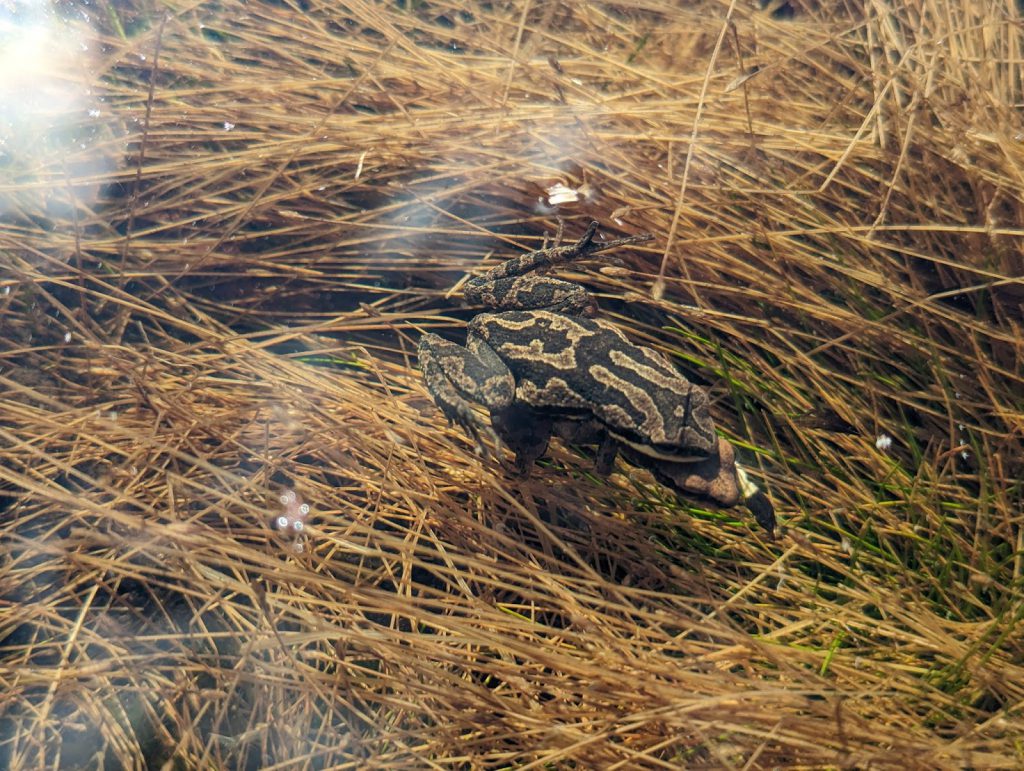Native Animal Profile: Chorus Frogs
Every year around this time, reports start rolling in of early spring frog calls—usually, it’s the charismatic wood frog (Lithobates sylvaticus) or well-known spring peeper (Psuedacris crucifer). Spring peepers are members of the Pseudacris genus, a group commonly called chorus frogs, all known for singing their songs of spring loudly and proudly. Maryland is home to three additional species of chorus frog, the upland chorus frog (Pseudacris feriarum), the New Jersey chorus frog (Pseudacris kalmi), and the mountain chorus frog (Pseudacris brachyphona—listed as Endangered in the state of Maryland).
All three are considered related to tree frogs, and from a naturalist’s perspective, can be highly frustrating to find; one moment they are piercingly loud in the wetland right next to you, and the next they are silent and invisible. In the case of the upland chorus frog, arguably the most common of the three, males are using their “crrreeek” sounding call (often described as the sound of running a finger along a comb) to attract females for mating in these months. Interestingly, sometimes silent males show a behavior called sexual interference, sitting quietly and innocently near calling males and then intercepting approaching females. The female lays large quantities of eggs attached to aquatic vegetation, and metamorphosis occurs in two to three months.
While all three of these species are listed as species of least concern for conservation range-wide, very real threats exist for these tiny tree dwellers. Amphibians like frogs have porous skin that they use as part of respiration, and all amphibians start their life cycles in water as soft, slimy eggs. As such, they are great indicators of water quality due to their sensitivity and reliance on aquatic ecosystems for reproduction. Viruses and fungal infections, spread by human industry and the pet trade and worsened by the growing climate crisis, pose a danger of terrifying proportions. The loss of any frog species could mean throwing a wrench in the balance of food webs and interconnected life cycles that could send ripples across multiple layers of species interactions.
How can you help support chorus frogs? If you fish or play in streams, make sure your gear is cleaned thoroughly between sites. If you find a frog, never handle it with dry hands; wetting your hands with fresh, non-chlorinated water is preferred. As always, plant native species whenever possible; these plants support a greater diversity of insects, providing food and habitat benefits to our frog friends. You can also provide great habitat by adding a water feature to your garden. Finally, support your local wildlife conservation program through a tax donation to our partners, the Chesapeake Bay Trust.
Check out local records of chorus frogs at the Maryland Biodiversity Project.
For more on Maryland’s frogs and toads, visit our website or check out The Maryland Amphibian and Reptile Atlas, published in 2018, which is full of photos, maps, and fun facts.
Spring is here, HabiChatters!
In this issue, you’ll find a native plant and native animal profile about some of the first (and best) harbingers of spring. Education Assistant Edwin Guevara offers some ways to get your teens into nature with technology; if you can’t get them off their screens, bring the screens outside! And last but not least, guest author Samantha Lott, one of our fantastic Natural Resources Technicians, offers us great insight and advice about dealing with the consequences of heavy spring rains. We hope you get outside as the weather warms up in your Wild Acres!
Sarah Witcher
Sarah.Witcher1@Maryland.gov
410-260-8566
Click here to have HabiChat—the quarterly backyard wildlife habitat newsletter from the Wild Acres program—delivered right to your inbox!
In this Issue



 1-888-373-7888
1-888-373-7888 233733
233733